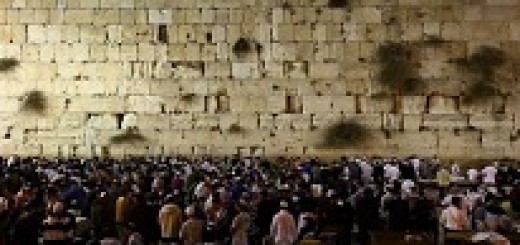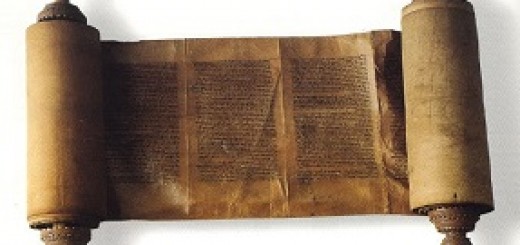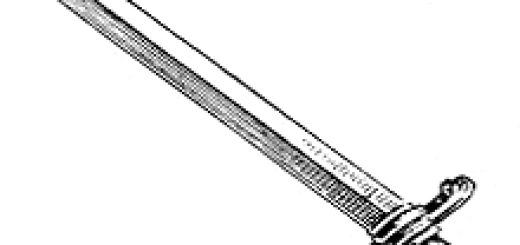To view as a Designed PDF, click here.
On the Shabbat of Parshat Chazon, the Temple is shown to every individual from afar. This Sicha analyzes the seemingly contradictory ideas of being “shown” from “afar,” the reason why the actual Temples themselves did not help to improve the behavior of the Jewish people and the special significance of when the 9th of Av falls on Shabbat.
The Shabbat of Parshat Chazon is referred to by that name due to the haftara which begins with the words (Yeshayahu 1:1): “A vision (chazon) of Yeshayahu the son of Amoz,” and deals with the destruction of Jerusalem.
Nevertheless, it is brought in the name of Rebbe, Rabbi Levi Yitzchak of Berditchev, that it is called by this name, as on this Shabbat, G-d shows each individual Jew a vision of the third Temple from afar.
Text 1
By way of allegory…of a father who has a precious child. He makes for him an expensive piece of clothing to clothe himself. However, because the child was not careful with the clothing and acted in a way that was improper, he ripped it into many shreds. (His father) made him a second article of precious clothing and again the child ripped it. What then did the father do? He made him a third article of clothing but did not give it to him to wear. Rather he hid it and in certain times he shows him the clothing, telling him: “See, if you act properly, this article of clothing will be given to you.” This trains the child to act properly until the point (the father) knows that it has become his nature. Then he gives him the clothing to wear, for he is no longer fearful that he will return to his negligent ways—for acting properly has become his nature. This is the idea of Shabbat Chazon: that each individual Jew is shown, from afar, the future Temple.
Ohr HaTorah, Nach, Vol. 2 Pg. 1097
The 9th of Av on Shabbat
When the Shabbat of Chazzon, falls out—as it does this year—on the day of the 9th of Av itself, this idea of the day is magnified and intensified.
This is clear as it is known that eventually all the days of fasting will be transformed into days of joy.
Text 2
All these [commemorative] fasts will be nullified in the Messianic era and, indeed ultimately, they will be transformed into holidays and days of rejoicing and celebration, as [Zechariah 8:19] states: “Thus declares the Lord of Hosts, ‘The fast of the fourth [month], the fast of the fifth [month], the fast of the seventh [month], and the fast of the tenth [month] will be [times of] happiness and celebration and festivals for the House of Yehudah. And they shall love truth and peace.’”
Rambam, Laws of Fasting 5:19
That being the case—that they will be transformed into holidays—it is understood that at the core, there is positivity in these days—even in our time. Indeed, that these days have some inherent positivity is stressed in the day of the 9th of Av.
Although, the 9th of Av is surely the most tragic on the Jewish calendar, there is a curious law concerning the day:
Text 3
One does not recite Tachanun nor Slichot on the 9th of Av, nor does one fall on their face, for it is called a holiday.
Shulchan Aruch, Orach Chaim 559:4
Indeed, the Jerusalem Talmud (Berachos 2:4) states that the 9th of Av is the birthday of Moshiach. Now, being that on ones birthday one’s spiritual power is amplified (JT Rosh HaShana 3:8), it is self-understood that the 9th day that is especially apropos to be redeemed. Actually, this is the very reason—according to Chassidut—that the 9th of Av is referred to as a holiday.
Being that the case, it is understood that when the actual fast is postponed to Sunday—what is postponed is the mourning; however, the holiday of the 9th of Av is celebrated on Shabbat. For although the fast is postponed, the day remains an auspicious day. Indeed, our partaking of pleasure on the 9th of Av—when it falls on Shabbat—is akin to the manner that it will be transformed in the days of Moshiach.
Being that the 9th of Av is one that is auspicious for redemption, it is clear that the manner in which we are shown the future temple is also amplified when Shabbat Chazon is as well the 9th of Av.
The purpose of the vision
One can appreciate the advantage of the vision that one sees when the 9th of Av is Shabbat through prefacing the explanation of the purpose of the vision to begin with.
As explained above, the ultimate purpose of the vision is to train the child to act properly “until the point (the father) knows that it has become his nature.” At that point, when G-d sees that we have learned the lessons of the previous destructions and can now act properly he will rebuild for us the third and final Temple. To explain this concept, Rabbi Levi Yitzchak elucidated an allegory of a father who sewed a garment for his wayward child.
Seemingly though, the allegory does not correlate properly to explain why G-d would show the Jewish People an image of the third Temple.
For, in the allegory, there is no special element in the actual clothing that causes the child to act properly. It is merely a reward for acting properly. Therefore, by the father withholding the garment, only showing it to him with the assurance that if he acts properly he will receive it, this indeed teaches the child to improve his behavior.
However, this is not at all similar to what is attempting to be brought out:
For, the Temple itself causes the Jewish People to be more G-dly as it is a place where one can experience G-dliness and the Divine Presence resides.
Accordingly, it must be understood. During the time before the destruction of the Temple the Jewish people experienced G-dliness when going to the Temple.
Text 4
Ten miracles were performed for our forefathers in the Holy Temple: No woman ever miscarried because of the smell of the holy meat. The holy meat never spoiled. Never was a fly seen in the slaughterhouse. Never did the High Priest have an accidental seminal discharge on Yom Kippur. The rains did not extinguish the wood-fire burning upon the altar. The wind did not prevail over the column of smoke [rising from the altar]. No disqualifying problem was ever discovered in the Omer offering, the Two Loaves or the Showbread. They stood crowded but had ample space in which to prostrate themselves. Never did a snake or scorpion cause injury in Jerusalem. And no man ever said to his fellow “My lodging in Jerusalem is too cramped for me.”
Mishna, Avot 5:5
That being the case it is not understood. Over the many years that the Jewish People made pilgrimage to the Temple, they nevertheless did not improve their wayward ways. This was the case although there were prophecies that rebuked them that their actions will cause exile and destruction.
That being the case, how is it possible that through merely being shown an image of the Temple from afar at far off intervals that this will cause them to change their ways to the extent that it become their very nature, when the actual temple did not have this affect upon them?!
A vision from afar
The explanation for this though is hinted in the words of Rabbi Levi Yitzchak who said “that each individual Jew is shown, from afar, the future Temple.”
The inherent contradiction in this statement will serve to understand the above question. For sight is expressive of two things: 1) that the article being seen is close by and 2) that it makes close, for through sight the minute details of the article are made known to the individual seeing it.
This idea of sight is explained in Chassidic thought to be the difference between seeing and hearing. Seeing is metaphorically explained to be close, while hearing is said to be far. When a person sees something it permeates the individual giving him an assurance that is not present in hearing.
For, when one sees something, all the arguments in the world will not convince him that he did not see it. Indeed, his sight is powerful than any intellectual argument otherwise.
This is expressed in the law that a witness is forbidden to judge:
Text 5
A witness cannot act as a judge… since they have seen him slay a person, they cannot find any defense for him.
Talmud, Rosh HaShana 26a
This is only when the judges were themselves witnesses, however, in an instance that the judges heard testimony from an individual that they completely believe, they are nevertheless able to find merit for the defendant.
That being the case, the statement “that each individual Jew is shown, from afar, the future Temple,” is not understood. If it is seen, it is clear that it is not from afar, but is rather close.
However, the explanation of the matter is that in these contradictory statements is stressed the two elements that are needed in order transform the actions of the Jewish People—that they should naturally act in a proper way to merit the future Temple.
Man and G-d
Concerning the building of the third Temple, there are two opinions brought about who it will be built by. One opinion is expressed in the Zohar (1:28a) that explains that it is a “building of G-d” and will be built by G-d. Indeed, this is as well the opinion brought by Talmudic commentators:
Text 6
The future Temple that we await to be built and prepared will be redeemed and come from heaven. As expressed in the verse (Shemot 15:17) “the sanctuary, O Lord, [which] Your hands founded.”
Rashi, Talmud, Sukka 41a
On the other hand, the Jerusalem Talmud (Megilla 1:11) states that man will build the Temple. Indeed, Rambam explains that this is one of the signs of Moshiach—that he will build the Temple.
Text 7
In the future, the Messianic king will arise and renew the Davidic dynasty, restoring it to its initial sovereignty. He will build the Temple and gather the dispersed of Israel.
Rambam, Laws of Kings 11:1
The reason that Rambam is so sure about this is because the construction of the Temple is a positive commandment, as the verse (Shemot 25:8) states: “And they shall make Me a sanctuary and I will dwell in their midst.”
Being that it is a commandment, it must therefore be something that the Jewish People do—themselves—and not merely done by G-d.
However, as explained in many places[1] it is entirely possible that both man and G-d will build the Temple.
This can be done in various ways: Either man will build the entire Temple, and within it will be enclothed the Temple that will descend from Heaven, or the Temple will descend from Heaven except for the gates and doors, which will be the same as King Solomon’s temple.
It is therefore understood that there are two elements in the Temple: one that is expressive of G-d and the other that is expressive of man’s efforts.
The reason why these two elements are necessary is due to the eternal nature of the third Temple.
Being that it is an everlasting edifice, it must be built by G-d—as only an eternal G-d’s actions can be eternal. On the other hand, in order that the Temple be everlasting in this world, there needs to be a certain element that man effectuates.
Being shown the Temple
Just as in the actual building of the Temple there is one element that is done by G-d and another affected by man—the same too is in the vision that is shown of the Temple on Shabbat Chazon. These two elements are hinted in the fact that on one hand we are shown the Temple and on the other that it is from afar.
The fact that on this Shabbat is “shown” the Temple is expressive that it is G-d that shows the Temple. Meaning to say: that not only is the Temple available to be seen, but there is an action—so to speak—by G-d in showing us the Temple. This is similar to this that third Temple will come through an act of G-d—from Heaven.
It is this element—that the Temple is shown to us—that answers the question as to why the actual first and second Temple did not transform us, but this image will.
Although in the first and second Temple the Jewish People went there, offered sacrifices, and witnessed the Divine Presence and miracles, which surely caused them to fear heaven, this is what they saw—through their own efforts. Not so with the image that is shown on Shabbat Chazon, which is a much deeper image, shown by G-d.
The difference between something that an individual is shown or that he sees on his own is both qualitatively and quantitatively different.
When an individual sees something on his own, he does not see all the details of the article—only the parts that he is able to see. However, when the article is shown to him, he sees all its details.
Additionally, when he sees the article on his own, he is only able to grasp it according to his finite abilities. However, when G-d shows it to him, he is able to show it in a manner that transcends the capabilities of man.
The same is the case concerning the Temples: In the first two temples, the Jewish People perceived the revelation therein on their own. That being the case, it is understood that they didn’t truly perceive the G-dlines that resided in the Temples as this is beyond man’s abilities.
However, when G-d shows us the third Temple, He shows it to us in the way that it truly is. We are able to perceive a level of G-dliness that would otherwise have been impossible if we ourselves were to gaze upon it.
It is for this reason that although the Jewish People traveled to the first two temples, the revelation did not completely transform them—that they should change their wayward ways. Only G-d showing us the third Temple is able to effectuate such a change.
This is because one is limited in the finite capabilities of man and the other has the limitless potential of G-d.
From afar
However, being that the image comes from G-d, not man, it is understood that although this change may be superimposed upon them by G-d, they themselves are not transformed.
This is the case as well concerning the various spiritual announcements that awaken an individual to repent. Being that they come from Heaven, they do not have a lasting effect on the person, unless he himself changes as well.
It is for this reason that the allegory stresses that “each individual Jew is shown, from afar, the future Temple.”
A person is to realize that although he perceives the deepest revelation of G-dliness that he remains distant from it. When a person meditates and contemplates this distance, this itself awakens within him a sense of nothingness that causes that he should be a proper receptacle to perceive G-dliness.
Accordingly can be answered another conundrum. As said before, the simple meaning of the word Shabbat Chazon is as it relates to the destruction of Jerusalem—things that are the very opposite of its being rebuilt.
That being the case, how can it be that in the same word is hinted the vision that is seen?
However, according to the above this question is answered. For the revelation of the vision must be accompanied with a feeling distance and destruction. Only when a person conjoins these two feelings can the vision effectuate its ultimate purpose.
Shabbat which is the 9th of Av
Now the advantage of Shabbat Chazon being the 9th of Av itself can be properly appreciated. In addition to its being a day that is shown the temple, it also the day of Moshiach’s birth. On this day it is stressed how he stands ready to redeem the Jewish people and rebuild the Temple.
This gives strength that not only shall we see the Temple from afar but that it should indeed be close.
May indeed we merit very speedily to the rebuilding of the third and eternal Temple!
(Based on Likutei Sichos 39, Masei 1, Shabbat Chazon pg. 8ff, reworked by Rabbi Dovid Markel.)
[1] See Likutei Sichos, Vol. 19 Pg. 418.






















